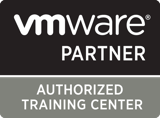Course outline
Duration : 5 days
| ||
This five-day course features intensive hands-on training that focuses on installing, configuring, and managing VMware vSphere 8, which includes VMware ESXi™ 8 and VMware vCenter® 8. This course prepares you to administer a vSphere infrastructure for an organization of any size. This course is the foundation for most VMware technologies in the software-defined data center. | |
Audience |
|
Prerequisites | This course has the following prerequisites:
|
Objectives | By the end of the course, you should be able to meet the following objectives:
|
Teaching method | |
Contents | 1 Course Introduction
2 vSphere and Virtualization Overview
3 Installing and Configuring ESXi
4 Deploying and Configuring vCenter
5 Configuring vSphere Networking
6 Configuring vSphere Storage
7 Deploying Virtual Machines
8 Managing Virtual Machines
9 Deploying and Configuring vSphere Clusters
10 Managing the vSphere Lifecycle
|

